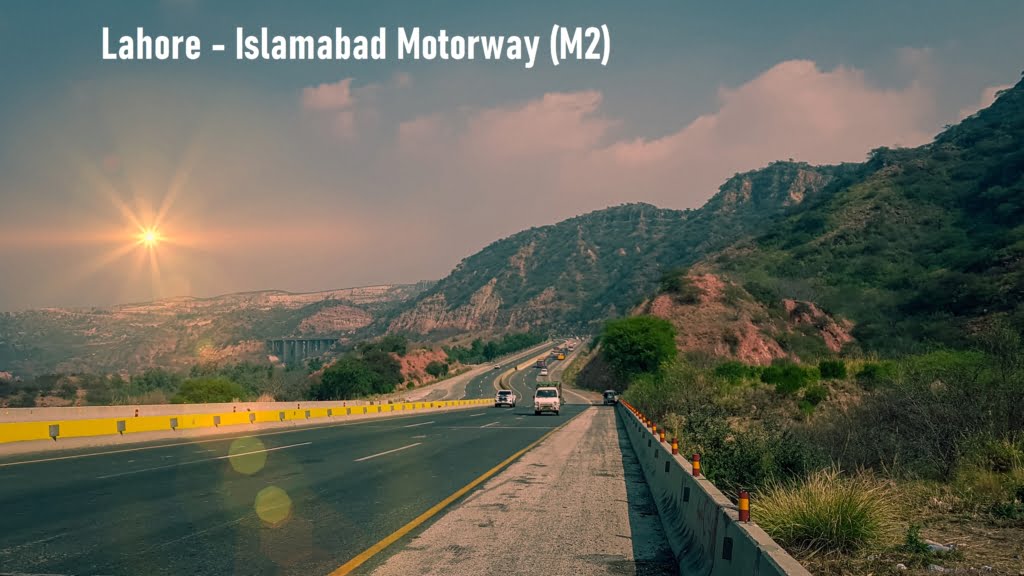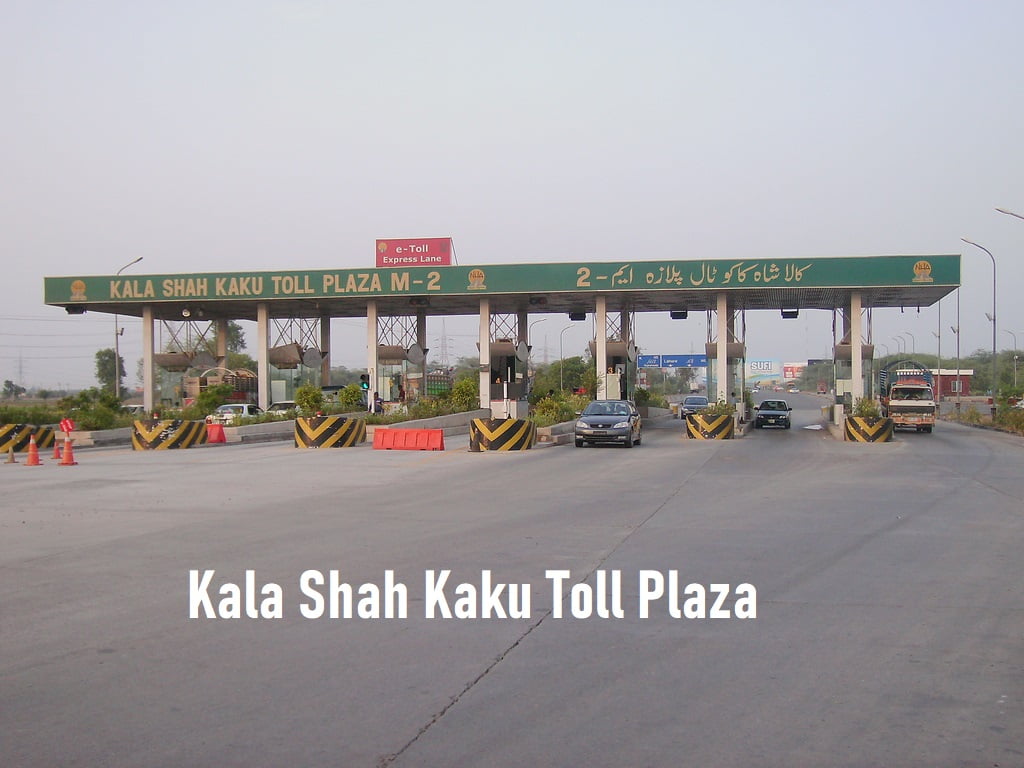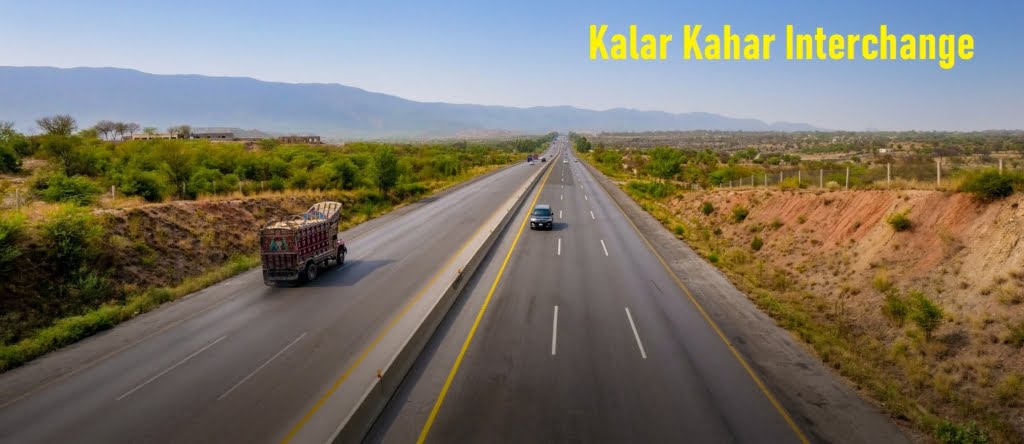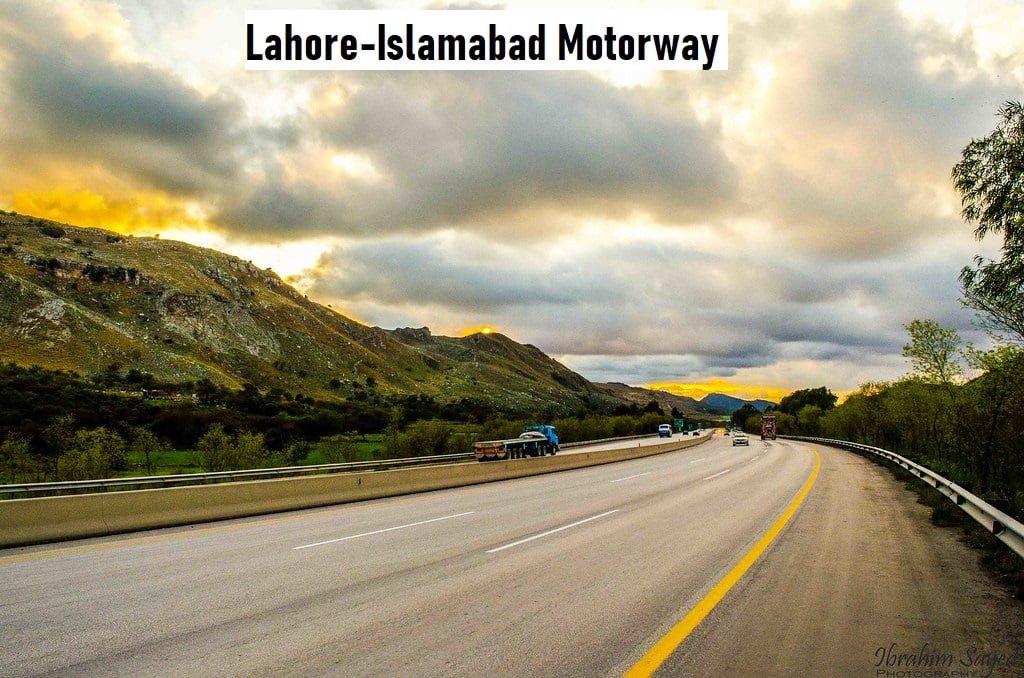Introduction to the Lahore-Islamabad Motorway (M-2)
The Lahore-Islamabad Motorway, commonly referred to as the M-2, stands as a pivotal artery in Pakistan’s transportation infrastructure. This 375-kilometer-long motorway serves as a critical link between the bustling urban centers of Lahore and Islamabad, fostering economic growth and facilitating swift travel. The inception of the M-2 dates back to the early 1990s when the need for a high-speed, modern roadway connecting these two key cities became increasingly apparent.
Construction of the Lahore-Islamabad Motorway commenced in 1992, with the ambitious project being spearheaded by the National Highway Authority (NHA). The motorway was officially opened to traffic in 1997, marking a significant milestone in Pakistan’s infrastructural development. The M-2 was designed to meet international standards, featuring dual carriageways, multiple lanes, and state-of-the-art facilities to ensure the safety and comfort of travelers.
The M-2 holds immense significance beyond mere connectivity. It has been instrumental in reducing travel time between Lahore and Islamabad from approximately 5-6 hours to just about 4 hours, thereby enhancing economic activities and intercity commuting. This motorway has not only improved the logistical flow of goods and services but has also spurred regional development, with numerous towns and businesses flourishing along its route.
Key milestones in the history of the Lahore-Islamabad Motorway include its initial planning phase, groundbreaking ceremonies, and subsequent expansions and upgrades. Over the years, the M-2 has undergone several enhancements to accommodate increasing traffic volumes and to maintain the quality of the roadway. These upgrades ensure that the motorway continues to meet evolving transportation needs while maintaining its status as a premier route in Pakistan.
In summary, the Lahore-Islamabad Motorway (M-2) is a testament to Pakistan’s commitment to fostering connectivity and economic growth through robust infrastructure. Its construction and subsequent success underscore the significance of well-planned transportation networks in national development and regional integration.
Route and Key Features
The Lahore-Islamabad Motorway, commonly known as the M-2, serves as a crucial artery connecting two of Pakistan’s major cities: Lahore and Islamabad. Spanning approximately 375 kilometers, the M-2 begins at Thokar Niaz Baig in Lahore and concludes at the junction with the M-1 near Islamabad. This motorway not only facilitates seamless travel between these urban centers but also significantly reduces travel time, making it a preferred choice for commuters and travelers alike.
Along its stretch, the M-2 passes through various important cities and towns, including Sheikhupura, Pindi Bhattian, Kot Momin, and Kallar Kahar. These locations are strategically positioned, providing access to regional hubs and fostering economic activities. Additionally, the motorway offers scenic views of the Salt Range near Kallar Kahar, adding a picturesque element to the journey.
The Lahore-Islamabad Motorway is renowned for its robust infrastructure and key features designed to enhance the travel experience. The motorway boasts a dual carriageway with six lanes — three in each direction — ensuring smooth and uninterrupted flow of traffic. This feature significantly contributes to reducing congestion and improving safety standards.
Travelers on the M-2 can avail themselves of various rest areas strategically located along the route. These rest areas are equipped with essential amenities such as fuel stations, restaurants, restrooms, and prayer areas, ensuring that travelers have access to necessary services during their journey. Additionally, the motorway is dotted with multiple toll plazas, which are efficiently managed to minimize delays and provide a seamless toll collection process.
Safety and security are paramount on the M-2 Motorway, with dedicated patrol units and emergency response teams deployed to assist in case of any incidents. The motorway is also well-lit and features clear signage, further enhancing the safety of travelers. These aspects collectively contribute to making the Lahore-Islamabad Motorway a model of modern road infrastructure in Pakistan.
Construction and Engineering Aspects
The Lahore-Islamabad Motorway, commonly known as the M-2, stands as a testament to modern engineering and construction prowess. Spanning approximately 375 kilometers, this motorway was constructed with meticulous attention to detail, utilizing top-tier materials such as high-grade asphalt and reinforced concrete to ensure durability and longevity. The design of the M-2 was meticulously planned to accommodate a high volume of traffic, incorporating features such as multi-lane carriageways, wide shoulders, and advanced drainage systems to enhance safety and efficiency.
One of the most remarkable engineering feats of the M-2 is its alignment through diverse terrains, including plains, hills, and rivers. This required innovative construction techniques and the implementation of state-of-the-art technology. For instance, the construction teams employed sophisticated tunneling methods for sections that traversed hilly regions, while expansive flyovers and bridges were erected to cross major water bodies and valleys. The challenges of dealing with varied topography were met with precision engineering and robust construction practices.
Several renowned engineering firms collaborated on this monumental project, bringing together a wealth of expertise and experience. The involvement of both local and international firms ensured that the best practices from around the globe were incorporated into the construction process. Additionally, the workforce comprised thousands of skilled laborers, engineers, and technicians who worked tirelessly to bring the M-2 to life. The coordination and dedication of these professionals were instrumental in overcoming the numerous challenges that arose during the construction phase.
Moreover, the M-2 motorway’s architecture includes strategically placed service areas and rest stops, designed with both functionality and aesthetics in mind. These facilities provide essential services to travelers, ensuring a comfortable and convenient journey. The integration of cutting-edge technology, such as intelligent traffic management systems and surveillance cameras, further enhances the safety and operational efficiency of the motorway.
In conclusion, the construction and engineering aspects of the Lahore-Islamabad Motorway (M-2) reflect an extraordinary blend of innovation, expertise, and resilience. This infrastructure marvel not only facilitates seamless connectivity between two major cities but also stands as a symbol of engineering excellence in Pakistan.
Economic Impact
The Lahore-Islamabad Motorway, commonly referred to as the M-2, has significantly influenced the economic landscape of Pakistan. This major infrastructure project has played a crucial role in enhancing trade and commerce between Lahore and Islamabad, acting as a vital artery that connects two of the country’s most important cities. The improved connectivity has reduced travel time, cut transportation costs, and facilitated the smoother movement of goods and services, thereby bolstering economic activity along the corridor.
One of the most notable economic benefits of the M-2 motorway is its impact on trade. The motorway has streamlined logistics operations, reducing the transit time for freight transport. This efficiency has led to increased trade volumes between Lahore and Islamabad, and has also positively affected adjacent regions by providing them with improved access to markets. The reduction in travel time has also helped businesses optimize their supply chains, leading to cost savings and increased profitability.
Tourism is another sector that has seen a boost due to the M-2 motorway. The scenic route has made travel more appealing, encouraging domestic tourism. Visitors find it easier to explore historical sites, cultural landmarks, and natural attractions located between Lahore and Islamabad. As a result, local businesses, including hotels, restaurants, and retail outlets, have experienced growth, contributing to the overall regional economy.
Furthermore, the M-2 motorway has contributed to the socio-economic development of the regions it traverses. Several towns and cities along the route have seen increased economic activity, with new businesses and industries emerging. This development has created job opportunities, improved local infrastructure, and raised the standard of living for many residents.
Statistics reveal the extent of the M-2 motorway’s economic impact. For instance, trade volumes between Lahore and Islamabad have reportedly increased by over 20% since the motorway’s completion. Additionally, tourism revenue in the regions connected by the M-2 has surged, with some areas reporting a 15% increase in tourist visits annually. These figures underscore the motorway’s role as a catalyst for economic growth.
In conclusion, the Lahore-Islamabad Motorway (M-2) has established itself as a pivotal infrastructure project that has facilitated trade, boosted tourism, and spurred regional economic development. Its contribution to the economic vitality of Pakistan is evident through the enhanced connectivity, increased trade volumes, and the socio-economic upliftment of the regions it serves.
Travel Experience and Services
The Lahore-Islamabad Motorway, commonly referred to as the M-2, offers a seamless travel experience for motorists journeying between these two major cities. Renowned for its well-maintained infrastructure, the M-2 ensures a smooth and comfortable drive. The quality of the road is exemplary, with regular maintenance ensuring that potholes and other disruptions are minimal. This emphasis on road quality significantly enhances the travel experience, making long-distance journeys less taxing on vehicles and passengers alike.
Safety is a paramount concern on the M-2. The motorway is equipped with a range of safety measures, including well-marked lanes, reflective road signs, and strategically placed speed cameras. The speed limit is strictly enforced, with passenger vehicles typically restricted to a maximum speed of 120 km/h, while heavy vehicles are limited to 100 km/h. These measures are instrumental in reducing accidents and ensuring a safe travel environment for all motorists.
Rest areas along the M2 Motorway are thoughtfully designed to cater to the needs of travelers. These areas are strategically located at regular intervals, offering a range of services that ensure a pleasant break from driving. Food courts provide a variety of dining options, from fast food to traditional Pakistani cuisine, catering to diverse tastes. Fuel stations are readily available, ensuring that motorists can refuel without deviating from their route. Additionally, clean and well-maintained washrooms are a staple at these rest areas, contributing to the overall comfort of the journey.
Environmental Considerations
The Lahore-Islamabad Motorway (M-2) has been designed with significant attention to environmental impact, ensuring that the construction and operation of this critical infrastructure project do not unduly harm the surrounding ecosystems. One of the primary measures taken to minimize environmental damage is the implementation of wildlife crossings. These crossings are strategically placed along the M-2 to facilitate the safe movement of animals, thereby reducing the risk of wildlife-vehicle collisions and maintaining natural habitats.
Noise pollution, a common concern with major highways, has also been addressed on the Lahore-Islamabad Motorway. Noise barriers have been installed in sensitive areas to mitigate the impact of traffic noise on nearby communities and wildlife. These barriers not only help in reducing noise pollution but also contribute to a more pleasant driving experience for motorists.
Landscaping efforts along the M-2 motorway play a crucial role in maintaining ecological balance. Native vegetation has been planted along the roadside to prevent soil erosion, enhance aesthetic appeal, and support local biodiversity. These efforts ensure that the motorway blends seamlessly with the natural landscape, promoting environmental sustainability.
In conclusion, the M-2 motorway stands as a testament to the possibility of developing essential infrastructure while prioritizing environmental considerations. Through careful planning and continuous efforts, the Lahore-Islamabad Motorway serves as a model for sustainable development, balancing the needs of modern transportation with the imperative of protecting our natural world.
Challenges and Future Prospects
The Lahore-Islamabad Motorway (M-2) has been a significant development in Pakistan‘s infrastructure, yet it has not been without its challenges. During the construction phase, the project faced numerous hurdles including land acquisition issues, funding constraints, and delays caused by socio-political factors. Once operational, maintenance issues quickly emerged as a notable challenge. The motorway’s extensive length and high usage necessitate constant upkeep, which is often hampered by budgetary and logistical constraints.
Traffic congestion is another pressing issue, particularly during peak travel seasons and holidays. The M-2 motorway is a critical link between Lahore and Islamabad, and its popularity has led to increased vehicular load, at times exceeding its designed capacity. This congestion not only affects travel time but also raises safety concerns, necessitating strategic planning and potential expansions to manage the growing traffic effectively.
Socio-political challenges have also impacted the M-2 motorway. Changes in government policies and priorities can lead to shifts in focus and funding, influencing the consistency and quality of maintenance and upgrades. Additionally, regional disputes and security concerns can impose restrictions on the free flow of traffic, further complicating the operational dynamics of this essential route.
Looking forward, the future prospects of the Lahore-Islamabad Motorway are optimistic with several potential upgrades and expansions being planned. These include widening certain sections to accommodate more lanes and the introduction of advanced traffic management systems to enhance efficiency. The integration of smart technology, such as real-time traffic monitoring and automated toll collection, is also under consideration to streamline operations and improve user experience.
Environmental sustainability is another area being explored, with initiatives aimed at reducing the carbon footprint of the motorway through better design and the promotion of electric vehicles. These future developments hold the promise of not only resolving current issues but also setting a new benchmark in the region’s infrastructure standards.
For many, the Lahore-Islamabad Motorway, commonly referred to as the M-2, is more than just a road; it is a lifeline that connects two of Pakistan’s major cities, facilitating travel and commerce. The personal stories and testimonials of frequent travelers, residents, and stakeholders illustrate the motorway’s significance in their daily lives.

Everyday Commutes and Unforgettable Journeys
Sarah Ahmed, a frequent traveler on the M-2, shares her experience: “As a business consultant, I often have to shuttle between Lahore and Islamabad. The M-2 has made my commute incredibly efficient. The well-maintained road and clear signage make the journey smooth, allowing me to focus on my work rather than the stress of travel.” Sarah’s experience highlights the motorway’s role in enhancing professional lives by saving time and reducing travel-related stress.
Similarly, Ahmed Khan, a resident of Lahore, recounts a memorable family trip: “We decided to take a road trip to Islamabad for a family wedding. The M-2 made our journey a pleasant experience. The scenic views and rest areas equipped with amenities provided us with a comfortable and enjoyable travel experience. It was a journey that brought our family closer together.”
M-Tag Facility at M-2 Motorway
Experience the convenience of the Mtag Facility at M2 Motorway, designed to streamline your travel with seamless electronic toll payments. This state-of-the-art system eliminates the need for cash, reducing congestion and enhancing your journey. Ideal for frequent travelers, the Mtag ensures a swift, hassle-free passage through toll plazas, making your trips more efficient and enjoyable. Upgrade to Mtag today and enjoy the benefits of faster, smoother travel on the M2 Motorway.
A Stakeholder’s Perspective
From the perspective of stakeholders, the Lahore-Islamabad Motorway is a pivotal infrastructure project. Rashid Mehmood, a logistics manager for a major distribution company, explains: “The M-2 is crucial for our operations. It allows us to transport goods between Lahore and Islamabad efficiently. The motorway’s infrastructure supports the timely delivery of products, which is essential for maintaining our supply chain. Without the M-2, our operations would face significant delays.”
These personal stories and testimonials underscore the Lahore-Islamabad Motorway’s role in transforming travel, enhancing business operations, and improving the quality of life for residents. The M-2 is not just a road; it is a vital artery that supports the economic and social fabric of the region.
Key Interchanges and Their Details
The Lahore-Islamabad Motorway (M-2) is a major artery in Pakistan’s transportation network, providing a vital link between Lahore and Islamabad. Spanning over 375 kilometers, this motorway is known for its efficiency and modern infrastructure. Here’s a detailed look at the key interchanges along the M-2, offering a guide to the various routes and connections available.
Starting Point: M-2 Zero Point, Lahore
The journey begins at the M-2 Zero Point in Lahore, where the motorway continues from Abdul Sattar Edhi Road. This marks the official start of the Lahore-Islamabad Motorway.
Key Interchanges and Their Connections
- Babu Sabu Interchange
- Connections: Band Road to Chowk Yatim Khana, LRR.
- Details: Facilitates access to Band Road and the Lahore Ring Road (LRR), crucial for navigating within Lahore.

- M-3 Lahore-Abdul Hakeem Interchange
- Connections: M-3 Motorway to Abdul Hakeem.
- Details: Connects the M-2 with the M-3, linking Lahore to Abdul Hakeem.
- Faiz Pure Interchange
- Connections: Lahore-Jaranwala Road to Jaranwala and Shahdara Town, Lahore.
- Details: Provides access to Jaranwala and Shahdara Town, key areas in Lahore.
- Kot Abdul Malik Interchange
- Connections: N-60 to Sheikhupura and Lahore.
- Details: A critical junction for travel between Sheikhupura and Lahore.
- Kala Shah Kaku Interchange
- Connections: Lahore Bypass to Kala Shah Kaku and N-5.
- Details: Facilitates movement to Kala Shah Kaku and the N-5 National Highway.
- Sheikhupura Interchange
- Connections: Gujranwala-Sheikhupura Road to Sheikhupura and Gujranwala.
- Details: Links Sheikhupura to Gujranwala, enhancing regional connectivity.
- Hiran Minar Interchange
- Connections: Jandiala-Sheikhupura Road to Hiran Minar, Sheikhupura, and Jandiala Sher Khan.
- Details: Offers routes to the historical Hiran Minar and nearby towns.
- Khanqah Dogran Interchange
- Connections: Khanqah Dogran Road to Khanqah Dogran and Hafizabad.
- Details: Important for access to Khanqah Dogran and Hafizabad.
- Sukheki Interchange
- Connections: Hafizabad-Sukheki Road to Sukheki and Hafizabad.
- Details: Connects travelers to Sukheki and Hafizabad, facilitating regional travel.
- M-4 Pindi Bhattian-Multan Interchange
- Connections: M-4 Motorway to Multan.
- Details: Integrates the M-2 with the M-4, connecting Pindi Bhattian to Multan.
- Pindi Bhattian Interchange
- Connections: Wazirabad Road to Pindi Bhattian, Chiniot, and Jhang.
- Details: Links to Pindi Bhattian and extends routes to Chiniot and Jhang.
- Makhdoom Interchange
- Connections: Sial-Phalia Road to Sial More and Sargodha.
- Details: Provides routes to Phalia and Gujrat from Sial More.
- Kot Momin Interchange
- Connections: Routes to Kot Momin and Bhalwal.
- Details: Enhances access to Kot Momin and Bhalwal.
- Saalam Interchange
- Connections: Sargodha-Gujrat Road to Bhalwal, Sargodha, and Mandi Bahauddin.
- Details: Facilitates travel to Sargodha, Gujrat, and Mandi Bahauddin.
- Bhera Interchange
- Connections: Bhera-Jhawarian Road to Jhawarian, Shahpur, Bhera, and Malakwal.
- Details: Key for accessing Bhera and surrounding areas.
- Lilla Interchange
- Connections: Pind Dadan Khan-Lilla Road to Lilla Town, Khushab, Pind Dadan Khan, and Jhelum.
- Details: Serves Lilla Town and connects to Khushab and Jhelum.
- Kallar Kahar Interchange
- Connections: Routes to Kallar Kahar, Choa Saidanshah, and Katas Raj Temples.
- Details: Important for accessing the scenic Kallar Kahar and historic Katas Raj Temples.

- Balkasar Interchange
- Connections: Talagang-Chakwal Road to Balkassar, Talagang, and Chakwal.
- Details: Links to Talagang and Chakwal.
- Neelah Dullah Interchange
- Connections: Neela-Basti Abdullah Road to Neela, Basti Abdullah, and Bhagwal.
- Details: Facilitates local travel to Neela and nearby areas.
- Chakri Interchange
- Connections: Chakri Road to Chakri and Rawalpindi.
- Details: Provides routes to Chakri and Rawalpindi.
- Thalian Interchange
- Connections: Airport Avenue to New Islamabad Airport and Thalian Road.
- Details: Key for travelers heading to the New Islamabad Airport.
- M-2-M1 Junction, Islamabad
- Connections: Islamabad Motorways Link Road to Islamabad/Rawalpindi.
- Details: Marks the transition from M-2 to M-1 towards Peshawar, linking to Islamabad and Rawalpindi.
Conclusion
The Lahore-Islamabad Motorway (M-2) is equipped with numerous interchanges, each facilitating seamless travel across various regions. From major cities to historical sites, these interchanges ensure that travelers can easily access their destinations, making the M-2 a crucial component of Pakistan’s road network.




